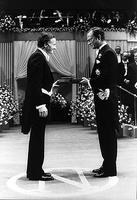
Laser
Laser (light amplification by stimulated emission of radiation), device used to generate high-intensity light. Unlike light from conventional sources, which is emitted incoherently (ie, light waves are unsynchronized or scattered) and over a range of frequencies, laser light is coherent (waves move in unison) and monochromatic (of a single colour/frequency). The frequency of the light emitted is determined by the nature of the atoms and molecules making up the laser medium. The maser is a similar device that emits coherent radiation at microwave frequencies. The 3 major components of a laser are the laser medium, an optical cavity for producing feedback (eg, pairs of mirrors), and a means of exciting the laser medium, thereby increasing the energy level (excitation) of the constituent atoms and molecules (eg, a flash lamp).
Types
Maser emission was first demonstrated in 1954 by J.P. Gordon, H.J. Zeiger and C.H. Townes at Columbia University. Arthur L. Schawlow, a graduate of the University of Toronto, and Townes proposed a technique for obtaining laser emission in a paper published in 1958. Operation of the first laser was reported by American physicist Theodore Maiman in 1960. This device had a ruby crystal medium.
The first gaseous laser, demonstrated in 1960, used a mixture of helium and neon as the laser medium and had an output power of 15 milliwatts. In 1960 John C. Polanyi, working at U of T, suggested a new type of laser based on the exchange of molecular vibrational energy in a gas. In 1964 this suggestion led to the development by C.K.N. Patel of the carbon dioxide laser, which operates in the infrared. Carbon dioxide lasers are the most powerful CW lasers available, with outputs of up to 100 000 W. An important advance in carbon dioxide laser technology, made in 1970 by A. Jacques Beaulieu, a scientist at the Defence Research Board laboratory in Valcartier, Qué, allowed these lasers to operate efficiently under pulsed conditions and has resulted in many new industrial applications for these devices. A recent advance permits pulsed operation using a mixture of halogen and inert gases (eg, fluorine and krypton). These excimer lasers operate in the ultraviolet with a combination of high-pulse energy and rapid repetition rate.
Applications
Lasers are widely used in many areas of technology. In industry the high power and narrow beams available have led to applications in materials forming, joining, machining, heat treating and marking. Lasers are extensively used in the manufacture of semiconductor elements and devices. The monochromaticity of laser radiation has opened up new areas in chemistry, through the use of laser radiation to modify chemical reactions and separate isotopes. In communications, lasers are used as optical transmission links, often through optical fibres.
The science of holography, the generation of 3-dimensional pictures, has expanded with laser development. In medicine, lasers are routinely used in eye surgery and, in the case of the carbon-dioxide laser, as a scalpel in various surgical techniques. Optical lasers, used to read the digital information on compact discs, have revolutionized the home audio industry. The ability of a laser to project a beam of light over vast distances has resulted in the use of lasers for remote sensing of atmospheric pollutants. Several studies are proceeding in which very high-power lasers are being used in an effort to achieve nuclear fusion.
See also Physics.

 Share on Facebook
Share on Facebook Share on X
Share on X Share by Email
Share by Email Share on Google Classroom
Share on Google Classroom

